COIT20249: 3D Printing Technology Applications and Recommendations
VerifiedAdded on 2023/06/12
|14
|3756
|319
Report
AI Summary
This report investigates the applications of 3D printing technology, focusing on customized super-casts, plastic weapons, prosthetic limbs, living organs, and lab-grown meat. It proposes three applications for a medium-sized manufacturing organization: customized super-casts for improved healing and user experience, bio-printing living organs to address the shortage of transplant tissues, and lab-grown meat as a cheaper, greener, and ethical food source. The report also discusses the advantages, disadvantages, risks, and solutions associated with each application, offering recommendations for the organization's business expansion using 3D printing technology. Desklib provides access to similar solved assignments and past papers for students.
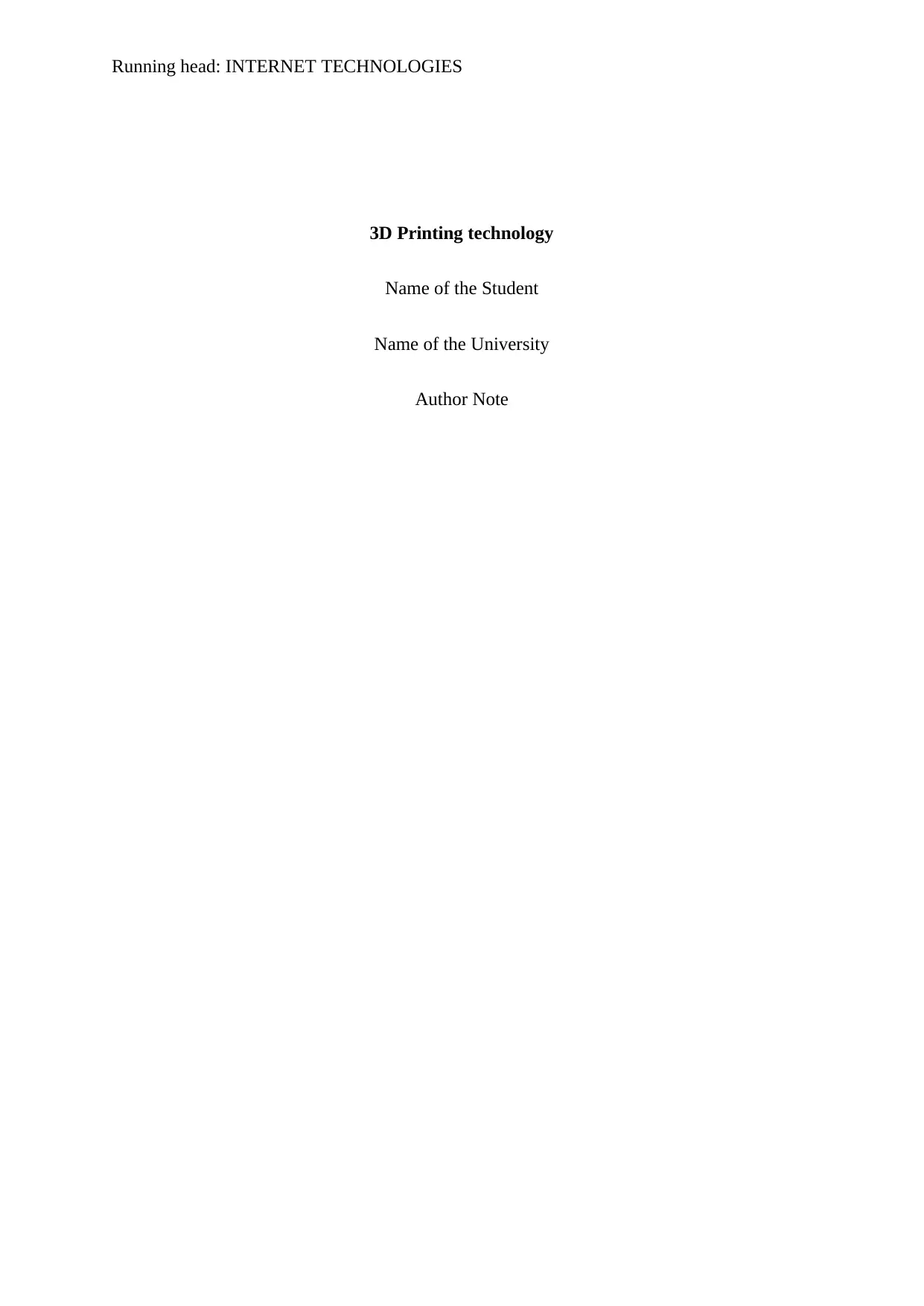
Running head: INTERNET TECHNOLOGIES
3D Printing technology
Name of the Student
Name of the University
Author Note
3D Printing technology
Name of the Student
Name of the University
Author Note
Paraphrase This Document
Need a fresh take? Get an instant paraphrase of this document with our AI Paraphraser
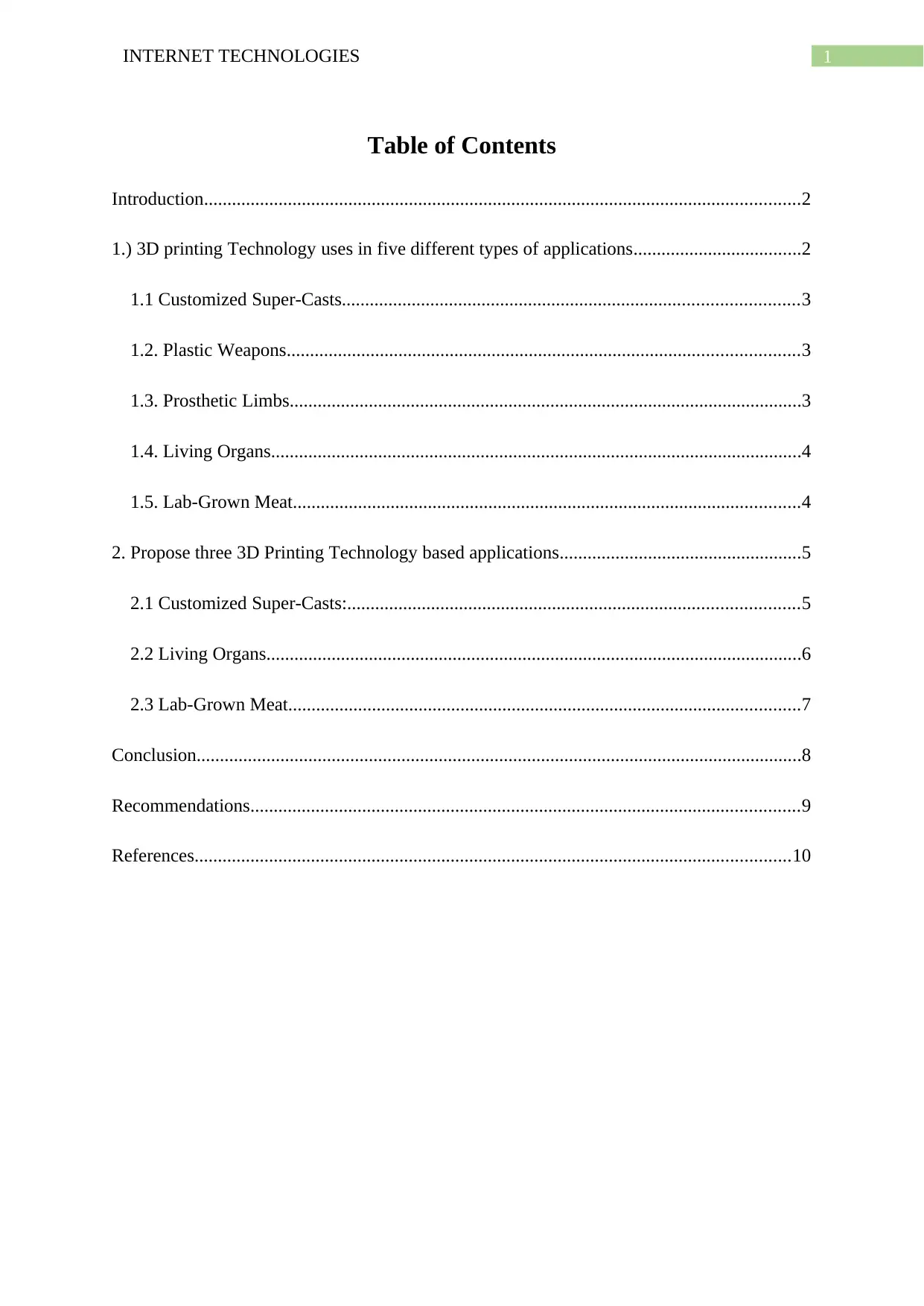
1INTERNET TECHNOLOGIES
Table of Contents
Introduction................................................................................................................................2
1.) 3D printing Technology uses in five different types of applications....................................2
1.1 Customized Super-Casts..................................................................................................3
1.2. Plastic Weapons..............................................................................................................3
1.3. Prosthetic Limbs..............................................................................................................3
1.4. Living Organs..................................................................................................................4
1.5. Lab-Grown Meat.............................................................................................................4
2. Propose three 3D Printing Technology based applications....................................................5
2.1 Customized Super-Casts:.................................................................................................5
2.2 Living Organs...................................................................................................................6
2.3 Lab-Grown Meat..............................................................................................................7
Conclusion..................................................................................................................................8
Recommendations......................................................................................................................9
References................................................................................................................................10
Table of Contents
Introduction................................................................................................................................2
1.) 3D printing Technology uses in five different types of applications....................................2
1.1 Customized Super-Casts..................................................................................................3
1.2. Plastic Weapons..............................................................................................................3
1.3. Prosthetic Limbs..............................................................................................................3
1.4. Living Organs..................................................................................................................4
1.5. Lab-Grown Meat.............................................................................................................4
2. Propose three 3D Printing Technology based applications....................................................5
2.1 Customized Super-Casts:.................................................................................................5
2.2 Living Organs...................................................................................................................6
2.3 Lab-Grown Meat..............................................................................................................7
Conclusion..................................................................................................................................8
Recommendations......................................................................................................................9
References................................................................................................................................10
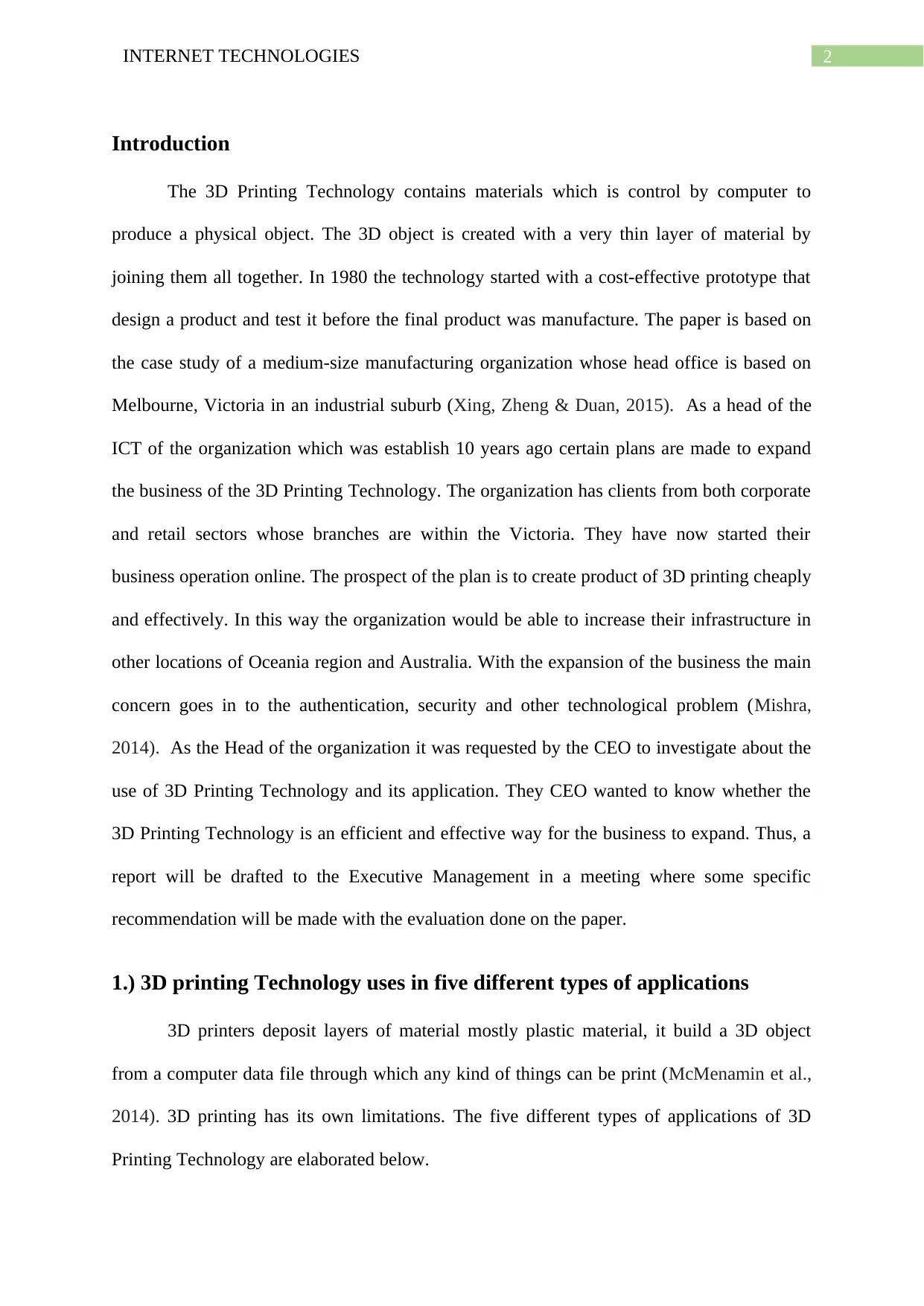
2INTERNET TECHNOLOGIES
Introduction
The 3D Printing Technology contains materials which is control by computer to
produce a physical object. The 3D object is created with a very thin layer of material by
joining them all together. In 1980 the technology started with a cost-effective prototype that
design a product and test it before the final product was manufacture. The paper is based on
the case study of a medium-size manufacturing organization whose head office is based on
Melbourne, Victoria in an industrial suburb (Xing, Zheng & Duan, 2015). As a head of the
ICT of the organization which was establish 10 years ago certain plans are made to expand
the business of the 3D Printing Technology. The organization has clients from both corporate
and retail sectors whose branches are within the Victoria. They have now started their
business operation online. The prospect of the plan is to create product of 3D printing cheaply
and effectively. In this way the organization would be able to increase their infrastructure in
other locations of Oceania region and Australia. With the expansion of the business the main
concern goes in to the authentication, security and other technological problem (Mishra,
2014). As the Head of the organization it was requested by the CEO to investigate about the
use of 3D Printing Technology and its application. They CEO wanted to know whether the
3D Printing Technology is an efficient and effective way for the business to expand. Thus, a
report will be drafted to the Executive Management in a meeting where some specific
recommendation will be made with the evaluation done on the paper.
1.) 3D printing Technology uses in five different types of applications
3D printers deposit layers of material mostly plastic material, it build a 3D object
from a computer data file through which any kind of things can be print (McMenamin et al.,
2014). 3D printing has its own limitations. The five different types of applications of 3D
Printing Technology are elaborated below.
Introduction
The 3D Printing Technology contains materials which is control by computer to
produce a physical object. The 3D object is created with a very thin layer of material by
joining them all together. In 1980 the technology started with a cost-effective prototype that
design a product and test it before the final product was manufacture. The paper is based on
the case study of a medium-size manufacturing organization whose head office is based on
Melbourne, Victoria in an industrial suburb (Xing, Zheng & Duan, 2015). As a head of the
ICT of the organization which was establish 10 years ago certain plans are made to expand
the business of the 3D Printing Technology. The organization has clients from both corporate
and retail sectors whose branches are within the Victoria. They have now started their
business operation online. The prospect of the plan is to create product of 3D printing cheaply
and effectively. In this way the organization would be able to increase their infrastructure in
other locations of Oceania region and Australia. With the expansion of the business the main
concern goes in to the authentication, security and other technological problem (Mishra,
2014). As the Head of the organization it was requested by the CEO to investigate about the
use of 3D Printing Technology and its application. They CEO wanted to know whether the
3D Printing Technology is an efficient and effective way for the business to expand. Thus, a
report will be drafted to the Executive Management in a meeting where some specific
recommendation will be made with the evaluation done on the paper.
1.) 3D printing Technology uses in five different types of applications
3D printers deposit layers of material mostly plastic material, it build a 3D object
from a computer data file through which any kind of things can be print (McMenamin et al.,
2014). 3D printing has its own limitations. The five different types of applications of 3D
Printing Technology are elaborated below.
⊘ This is a preview!⊘
Do you want full access?
Subscribe today to unlock all pages.

Trusted by 1+ million students worldwide
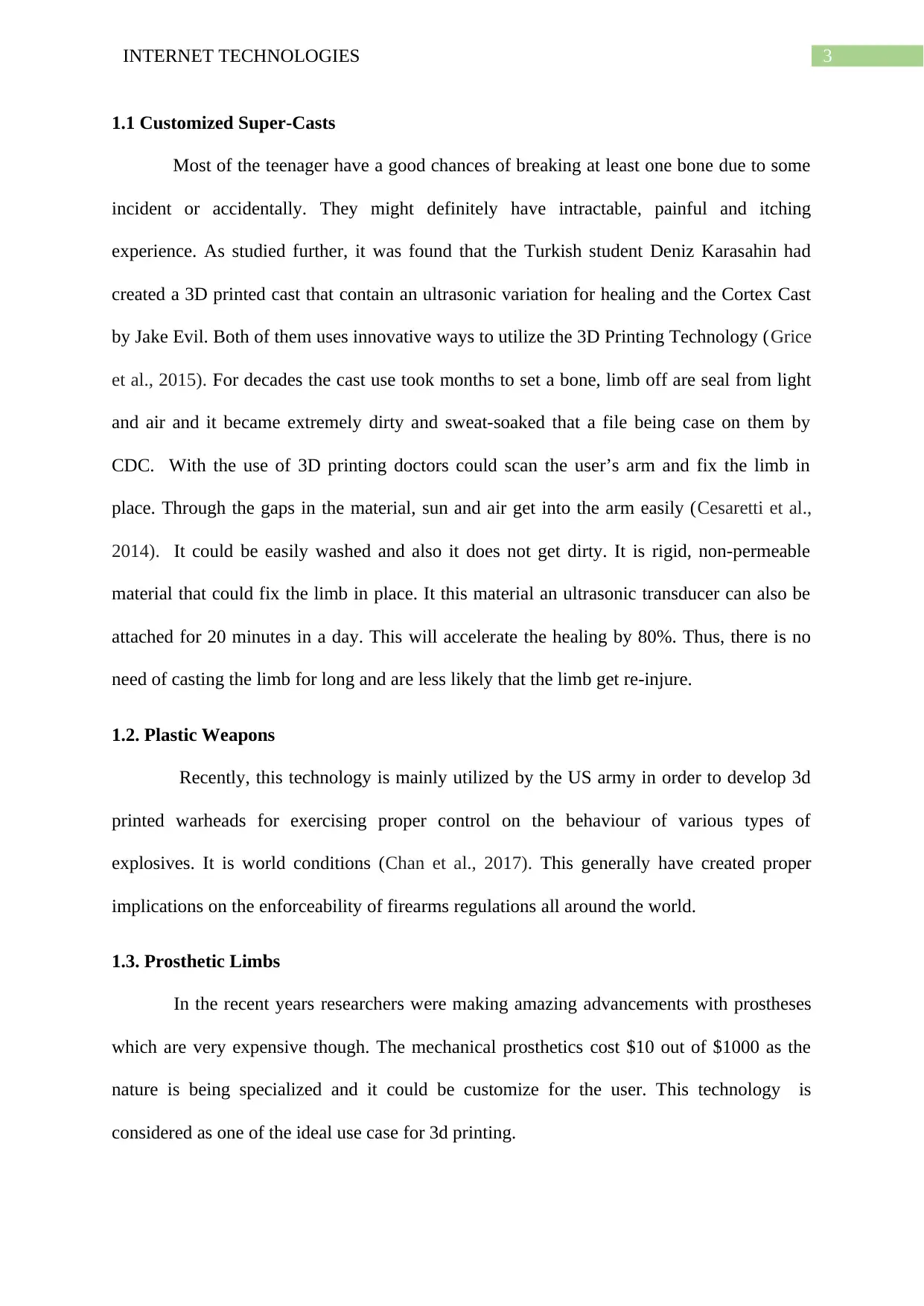
3INTERNET TECHNOLOGIES
1.1 Customized Super-Casts
Most of the teenager have a good chances of breaking at least one bone due to some
incident or accidentally. They might definitely have intractable, painful and itching
experience. As studied further, it was found that the Turkish student Deniz Karasahin had
created a 3D printed cast that contain an ultrasonic variation for healing and the Cortex Cast
by Jake Evil. Both of them uses innovative ways to utilize the 3D Printing Technology (Grice
et al., 2015). For decades the cast use took months to set a bone, limb off are seal from light
and air and it became extremely dirty and sweat-soaked that a file being case on them by
CDC. With the use of 3D printing doctors could scan the user’s arm and fix the limb in
place. Through the gaps in the material, sun and air get into the arm easily (Cesaretti et al.,
2014). It could be easily washed and also it does not get dirty. It is rigid, non-permeable
material that could fix the limb in place. It this material an ultrasonic transducer can also be
attached for 20 minutes in a day. This will accelerate the healing by 80%. Thus, there is no
need of casting the limb for long and are less likely that the limb get re-injure.
1.2. Plastic Weapons
Recently, this technology is mainly utilized by the US army in order to develop 3d
printed warheads for exercising proper control on the behaviour of various types of
explosives. It is world conditions (Chan et al., 2017). This generally have created proper
implications on the enforceability of firearms regulations all around the world.
1.3. Prosthetic Limbs
In the recent years researchers were making amazing advancements with prostheses
which are very expensive though. The mechanical prosthetics cost $10 out of $1000 as the
nature is being specialized and it could be customize for the user. This technology is
considered as one of the ideal use case for 3d printing.
1.1 Customized Super-Casts
Most of the teenager have a good chances of breaking at least one bone due to some
incident or accidentally. They might definitely have intractable, painful and itching
experience. As studied further, it was found that the Turkish student Deniz Karasahin had
created a 3D printed cast that contain an ultrasonic variation for healing and the Cortex Cast
by Jake Evil. Both of them uses innovative ways to utilize the 3D Printing Technology (Grice
et al., 2015). For decades the cast use took months to set a bone, limb off are seal from light
and air and it became extremely dirty and sweat-soaked that a file being case on them by
CDC. With the use of 3D printing doctors could scan the user’s arm and fix the limb in
place. Through the gaps in the material, sun and air get into the arm easily (Cesaretti et al.,
2014). It could be easily washed and also it does not get dirty. It is rigid, non-permeable
material that could fix the limb in place. It this material an ultrasonic transducer can also be
attached for 20 minutes in a day. This will accelerate the healing by 80%. Thus, there is no
need of casting the limb for long and are less likely that the limb get re-injure.
1.2. Plastic Weapons
Recently, this technology is mainly utilized by the US army in order to develop 3d
printed warheads for exercising proper control on the behaviour of various types of
explosives. It is world conditions (Chan et al., 2017). This generally have created proper
implications on the enforceability of firearms regulations all around the world.
1.3. Prosthetic Limbs
In the recent years researchers were making amazing advancements with prostheses
which are very expensive though. The mechanical prosthetics cost $10 out of $1000 as the
nature is being specialized and it could be customize for the user. This technology is
considered as one of the ideal use case for 3d printing.
Paraphrase This Document
Need a fresh take? Get an instant paraphrase of this document with our AI Paraphraser
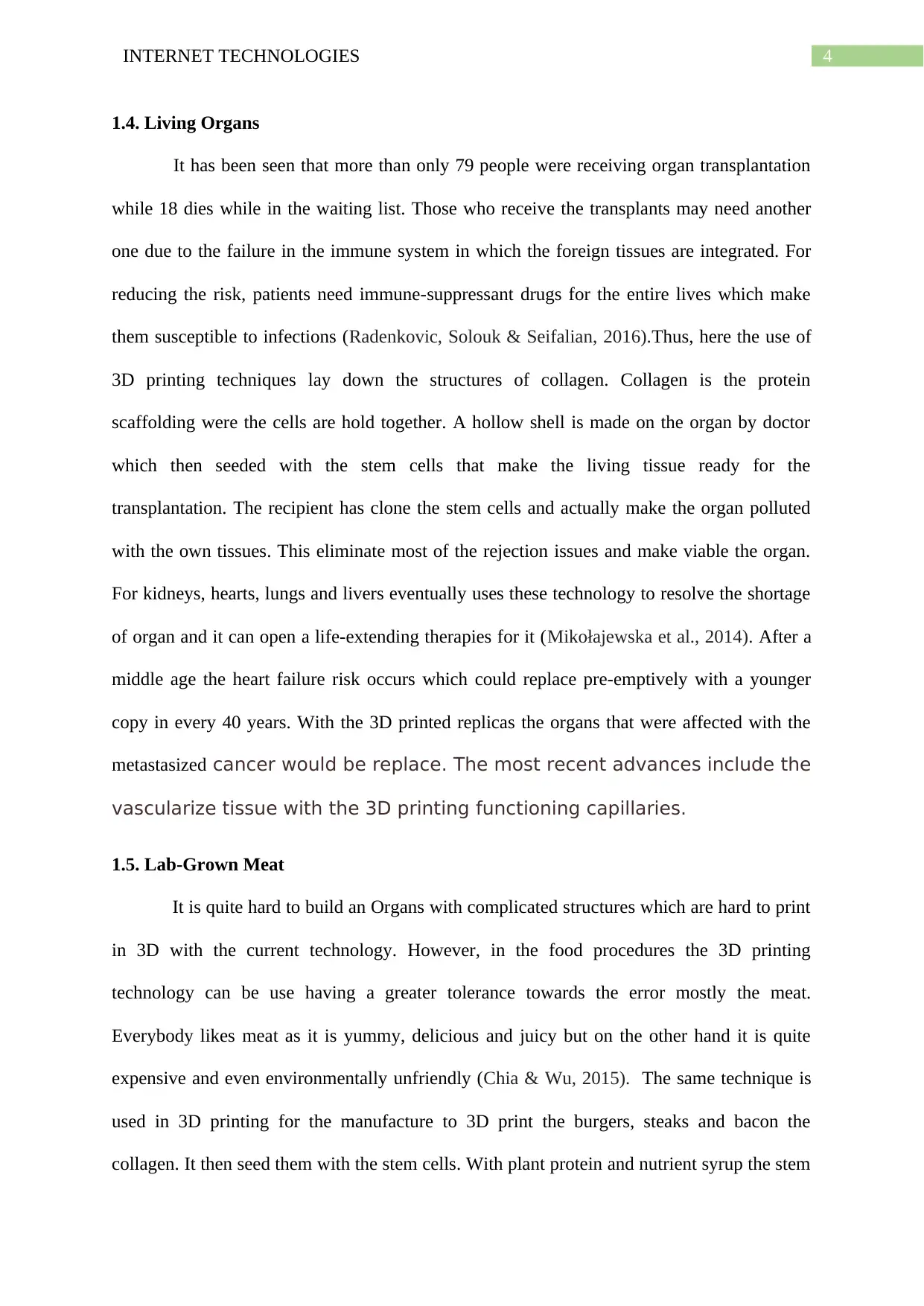
4INTERNET TECHNOLOGIES
1.4. Living Organs
It has been seen that more than only 79 people were receiving organ transplantation
while 18 dies while in the waiting list. Those who receive the transplants may need another
one due to the failure in the immune system in which the foreign tissues are integrated. For
reducing the risk, patients need immune-suppressant drugs for the entire lives which make
them susceptible to infections (Radenkovic, Solouk & Seifalian, 2016).Thus, here the use of
3D printing techniques lay down the structures of collagen. Collagen is the protein
scaffolding were the cells are hold together. A hollow shell is made on the organ by doctor
which then seeded with the stem cells that make the living tissue ready for the
transplantation. The recipient has clone the stem cells and actually make the organ polluted
with the own tissues. This eliminate most of the rejection issues and make viable the organ.
For kidneys, hearts, lungs and livers eventually uses these technology to resolve the shortage
of organ and it can open a life-extending therapies for it (Mikołajewska et al., 2014). After a
middle age the heart failure risk occurs which could replace pre-emptively with a younger
copy in every 40 years. With the 3D printed replicas the organs that were affected with the
metastasized cancer would be replace. The most recent advances include the
vascularize tissue with the 3D printing functioning capillaries.
1.5. Lab-Grown Meat
It is quite hard to build an Organs with complicated structures which are hard to print
in 3D with the current technology. However, in the food procedures the 3D printing
technology can be use having a greater tolerance towards the error mostly the meat.
Everybody likes meat as it is yummy, delicious and juicy but on the other hand it is quite
expensive and even environmentally unfriendly (Chia & Wu, 2015). The same technique is
used in 3D printing for the manufacture to 3D print the burgers, steaks and bacon the
collagen. It then seed them with the stem cells. With plant protein and nutrient syrup the stem
1.4. Living Organs
It has been seen that more than only 79 people were receiving organ transplantation
while 18 dies while in the waiting list. Those who receive the transplants may need another
one due to the failure in the immune system in which the foreign tissues are integrated. For
reducing the risk, patients need immune-suppressant drugs for the entire lives which make
them susceptible to infections (Radenkovic, Solouk & Seifalian, 2016).Thus, here the use of
3D printing techniques lay down the structures of collagen. Collagen is the protein
scaffolding were the cells are hold together. A hollow shell is made on the organ by doctor
which then seeded with the stem cells that make the living tissue ready for the
transplantation. The recipient has clone the stem cells and actually make the organ polluted
with the own tissues. This eliminate most of the rejection issues and make viable the organ.
For kidneys, hearts, lungs and livers eventually uses these technology to resolve the shortage
of organ and it can open a life-extending therapies for it (Mikołajewska et al., 2014). After a
middle age the heart failure risk occurs which could replace pre-emptively with a younger
copy in every 40 years. With the 3D printed replicas the organs that were affected with the
metastasized cancer would be replace. The most recent advances include the
vascularize tissue with the 3D printing functioning capillaries.
1.5. Lab-Grown Meat
It is quite hard to build an Organs with complicated structures which are hard to print
in 3D with the current technology. However, in the food procedures the 3D printing
technology can be use having a greater tolerance towards the error mostly the meat.
Everybody likes meat as it is yummy, delicious and juicy but on the other hand it is quite
expensive and even environmentally unfriendly (Chia & Wu, 2015). The same technique is
used in 3D printing for the manufacture to 3D print the burgers, steaks and bacon the
collagen. It then seed them with the stem cells. With plant protein and nutrient syrup the stem
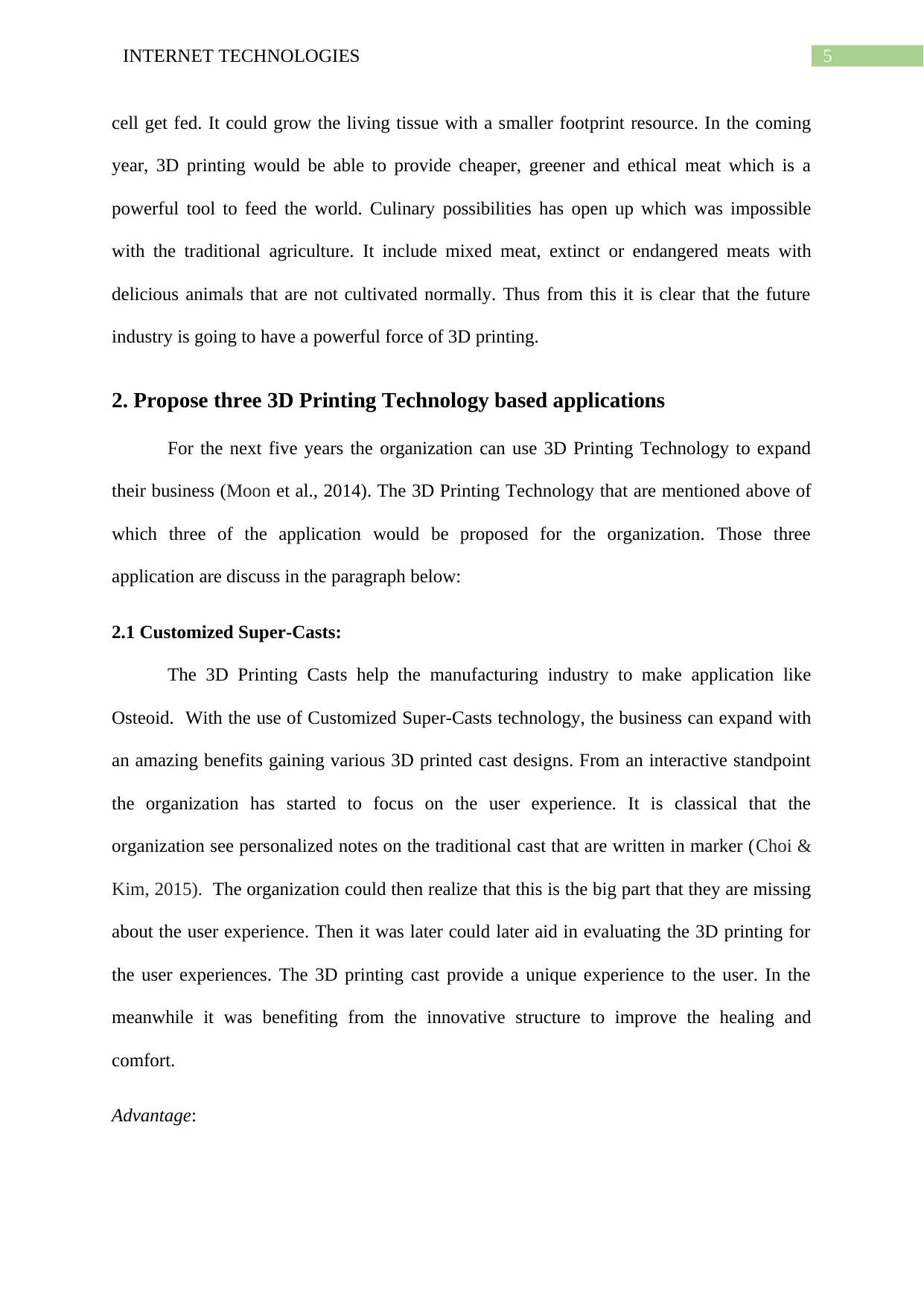
5INTERNET TECHNOLOGIES
cell get fed. It could grow the living tissue with a smaller footprint resource. In the coming
year, 3D printing would be able to provide cheaper, greener and ethical meat which is a
powerful tool to feed the world. Culinary possibilities has open up which was impossible
with the traditional agriculture. It include mixed meat, extinct or endangered meats with
delicious animals that are not cultivated normally. Thus from this it is clear that the future
industry is going to have a powerful force of 3D printing.
2. Propose three 3D Printing Technology based applications
For the next five years the organization can use 3D Printing Technology to expand
their business (Moon et al., 2014). The 3D Printing Technology that are mentioned above of
which three of the application would be proposed for the organization. Those three
application are discuss in the paragraph below:
2.1 Customized Super-Casts:
The 3D Printing Casts help the manufacturing industry to make application like
Osteoid. With the use of Customized Super-Casts technology, the business can expand with
an amazing benefits gaining various 3D printed cast designs. From an interactive standpoint
the organization has started to focus on the user experience. It is classical that the
organization see personalized notes on the traditional cast that are written in marker (Choi &
Kim, 2015). The organization could then realize that this is the big part that they are missing
about the user experience. Then it was later could later aid in evaluating the 3D printing for
the user experiences. The 3D printing cast provide a unique experience to the user. In the
meanwhile it was benefiting from the innovative structure to improve the healing and
comfort.
Advantage:
cell get fed. It could grow the living tissue with a smaller footprint resource. In the coming
year, 3D printing would be able to provide cheaper, greener and ethical meat which is a
powerful tool to feed the world. Culinary possibilities has open up which was impossible
with the traditional agriculture. It include mixed meat, extinct or endangered meats with
delicious animals that are not cultivated normally. Thus from this it is clear that the future
industry is going to have a powerful force of 3D printing.
2. Propose three 3D Printing Technology based applications
For the next five years the organization can use 3D Printing Technology to expand
their business (Moon et al., 2014). The 3D Printing Technology that are mentioned above of
which three of the application would be proposed for the organization. Those three
application are discuss in the paragraph below:
2.1 Customized Super-Casts:
The 3D Printing Casts help the manufacturing industry to make application like
Osteoid. With the use of Customized Super-Casts technology, the business can expand with
an amazing benefits gaining various 3D printed cast designs. From an interactive standpoint
the organization has started to focus on the user experience. It is classical that the
organization see personalized notes on the traditional cast that are written in marker (Choi &
Kim, 2015). The organization could then realize that this is the big part that they are missing
about the user experience. Then it was later could later aid in evaluating the 3D printing for
the user experiences. The 3D printing cast provide a unique experience to the user. In the
meanwhile it was benefiting from the innovative structure to improve the healing and
comfort.
Advantage:
⊘ This is a preview!⊘
Do you want full access?
Subscribe today to unlock all pages.

Trusted by 1+ million students worldwide
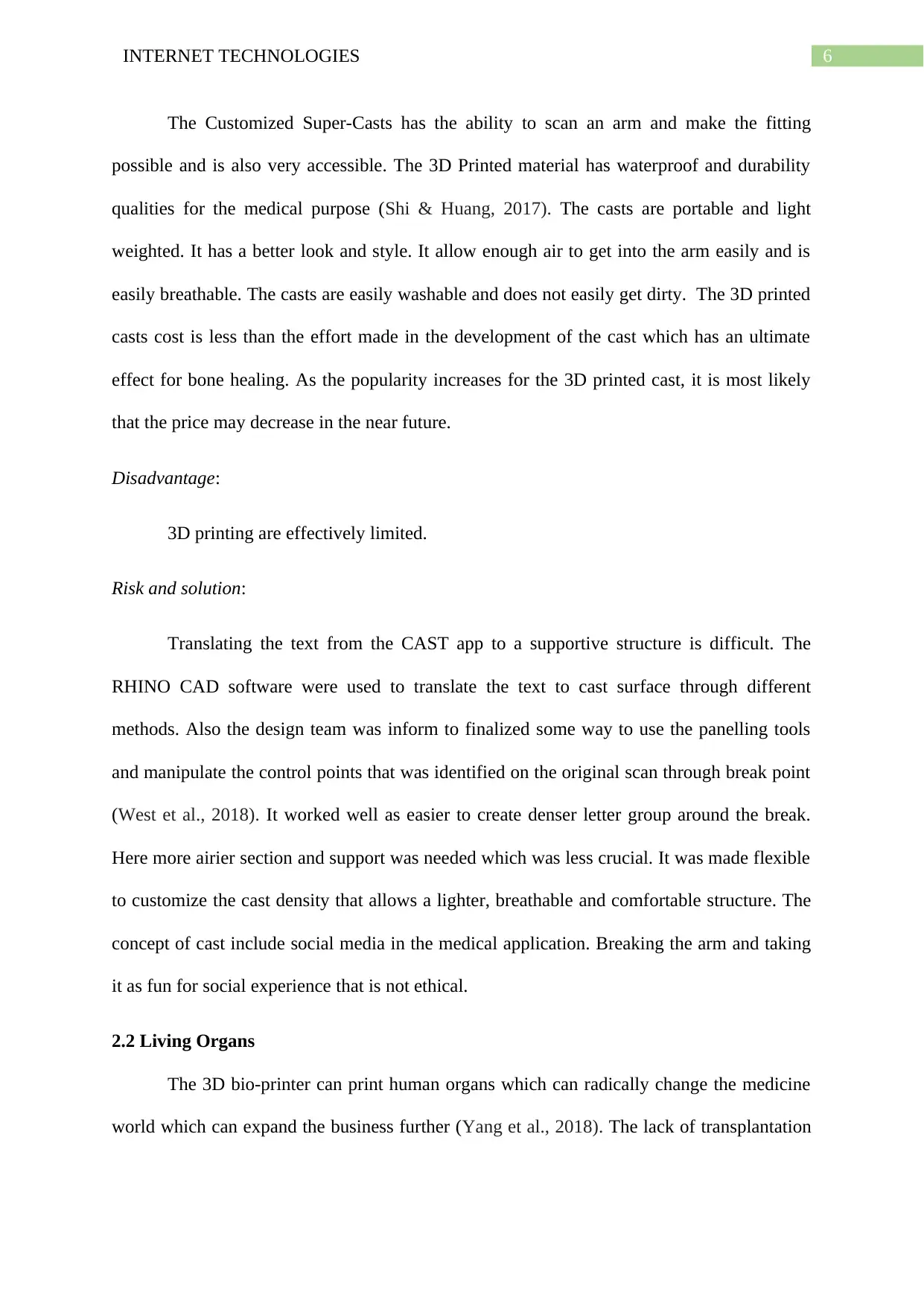
6INTERNET TECHNOLOGIES
The Customized Super-Casts has the ability to scan an arm and make the fitting
possible and is also very accessible. The 3D Printed material has waterproof and durability
qualities for the medical purpose (Shi & Huang, 2017). The casts are portable and light
weighted. It has a better look and style. It allow enough air to get into the arm easily and is
easily breathable. The casts are easily washable and does not easily get dirty. The 3D printed
casts cost is less than the effort made in the development of the cast which has an ultimate
effect for bone healing. As the popularity increases for the 3D printed cast, it is most likely
that the price may decrease in the near future.
Disadvantage:
3D printing are effectively limited.
Risk and solution:
Translating the text from the CAST app to a supportive structure is difficult. The
RHINO CAD software were used to translate the text to cast surface through different
methods. Also the design team was inform to finalized some way to use the panelling tools
and manipulate the control points that was identified on the original scan through break point
(West et al., 2018). It worked well as easier to create denser letter group around the break.
Here more airier section and support was needed which was less crucial. It was made flexible
to customize the cast density that allows a lighter, breathable and comfortable structure. The
concept of cast include social media in the medical application. Breaking the arm and taking
it as fun for social experience that is not ethical.
2.2 Living Organs
The 3D bio-printer can print human organs which can radically change the medicine
world which can expand the business further (Yang et al., 2018). The lack of transplantation
The Customized Super-Casts has the ability to scan an arm and make the fitting
possible and is also very accessible. The 3D Printed material has waterproof and durability
qualities for the medical purpose (Shi & Huang, 2017). The casts are portable and light
weighted. It has a better look and style. It allow enough air to get into the arm easily and is
easily breathable. The casts are easily washable and does not easily get dirty. The 3D printed
casts cost is less than the effort made in the development of the cast which has an ultimate
effect for bone healing. As the popularity increases for the 3D printed cast, it is most likely
that the price may decrease in the near future.
Disadvantage:
3D printing are effectively limited.
Risk and solution:
Translating the text from the CAST app to a supportive structure is difficult. The
RHINO CAD software were used to translate the text to cast surface through different
methods. Also the design team was inform to finalized some way to use the panelling tools
and manipulate the control points that was identified on the original scan through break point
(West et al., 2018). It worked well as easier to create denser letter group around the break.
Here more airier section and support was needed which was less crucial. It was made flexible
to customize the cast density that allows a lighter, breathable and comfortable structure. The
concept of cast include social media in the medical application. Breaking the arm and taking
it as fun for social experience that is not ethical.
2.2 Living Organs
The 3D bio-printer can print human organs which can radically change the medicine
world which can expand the business further (Yang et al., 2018). The lack of transplantation
Paraphrase This Document
Need a fresh take? Get an instant paraphrase of this document with our AI Paraphraser
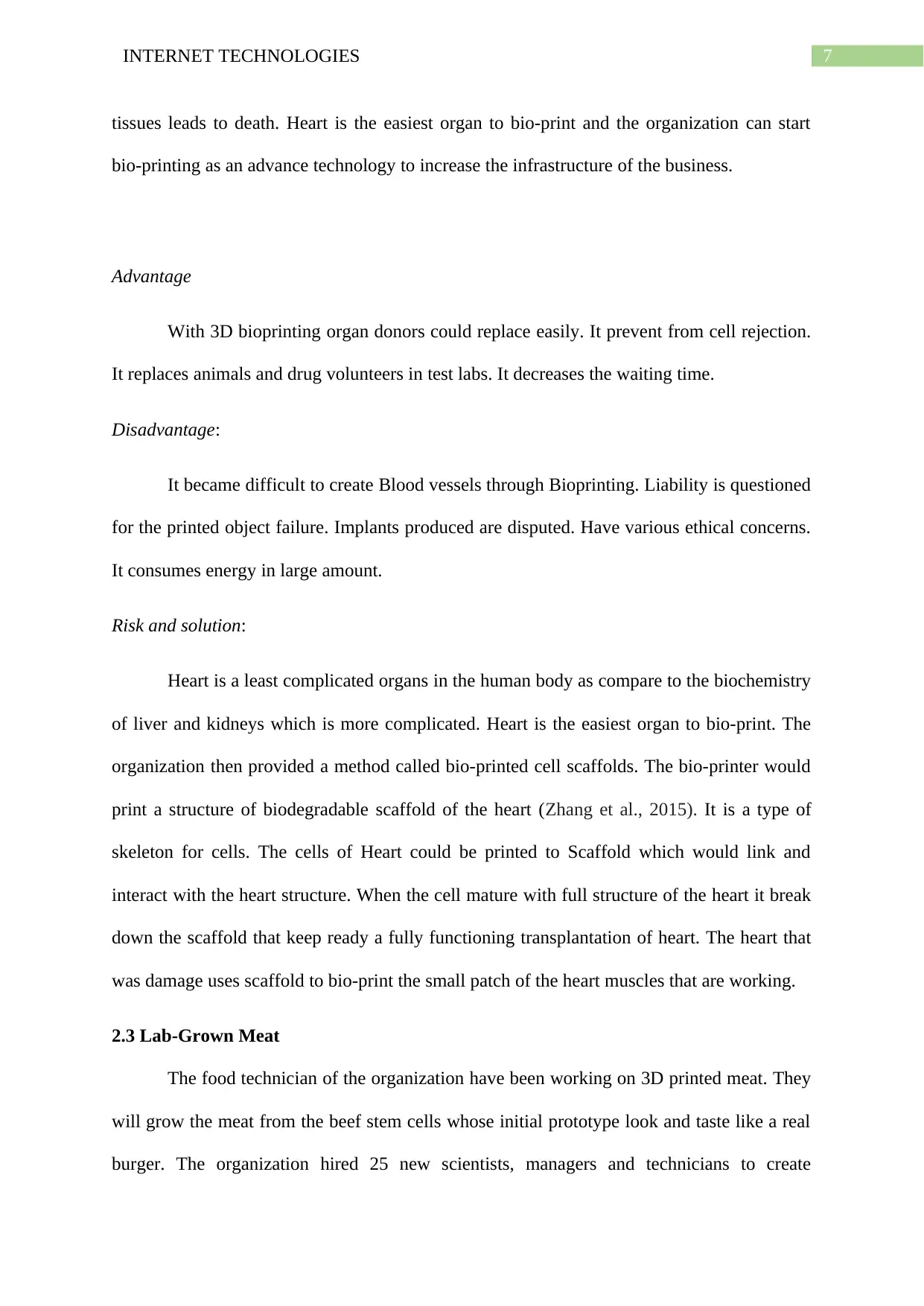
7INTERNET TECHNOLOGIES
tissues leads to death. Heart is the easiest organ to bio-print and the organization can start
bio-printing as an advance technology to increase the infrastructure of the business.
Advantage
With 3D bioprinting organ donors could replace easily. It prevent from cell rejection.
It replaces animals and drug volunteers in test labs. It decreases the waiting time.
Disadvantage:
It became difficult to create Blood vessels through Bioprinting. Liability is questioned
for the printed object failure. Implants produced are disputed. Have various ethical concerns.
It consumes energy in large amount.
Risk and solution:
Heart is a least complicated organs in the human body as compare to the biochemistry
of liver and kidneys which is more complicated. Heart is the easiest organ to bio-print. The
organization then provided a method called bio-printed cell scaffolds. The bio-printer would
print a structure of biodegradable scaffold of the heart (Zhang et al., 2015). It is a type of
skeleton for cells. The cells of Heart could be printed to Scaffold which would link and
interact with the heart structure. When the cell mature with full structure of the heart it break
down the scaffold that keep ready a fully functioning transplantation of heart. The heart that
was damage uses scaffold to bio-print the small patch of the heart muscles that are working.
2.3 Lab-Grown Meat
The food technician of the organization have been working on 3D printed meat. They
will grow the meat from the beef stem cells whose initial prototype look and taste like a real
burger. The organization hired 25 new scientists, managers and technicians to create
tissues leads to death. Heart is the easiest organ to bio-print and the organization can start
bio-printing as an advance technology to increase the infrastructure of the business.
Advantage
With 3D bioprinting organ donors could replace easily. It prevent from cell rejection.
It replaces animals and drug volunteers in test labs. It decreases the waiting time.
Disadvantage:
It became difficult to create Blood vessels through Bioprinting. Liability is questioned
for the printed object failure. Implants produced are disputed. Have various ethical concerns.
It consumes energy in large amount.
Risk and solution:
Heart is a least complicated organs in the human body as compare to the biochemistry
of liver and kidneys which is more complicated. Heart is the easiest organ to bio-print. The
organization then provided a method called bio-printed cell scaffolds. The bio-printer would
print a structure of biodegradable scaffold of the heart (Zhang et al., 2015). It is a type of
skeleton for cells. The cells of Heart could be printed to Scaffold which would link and
interact with the heart structure. When the cell mature with full structure of the heart it break
down the scaffold that keep ready a fully functioning transplantation of heart. The heart that
was damage uses scaffold to bio-print the small patch of the heart muscles that are working.
2.3 Lab-Grown Meat
The food technician of the organization have been working on 3D printed meat. They
will grow the meat from the beef stem cells whose initial prototype look and taste like a real
burger. The organization hired 25 new scientists, managers and technicians to create
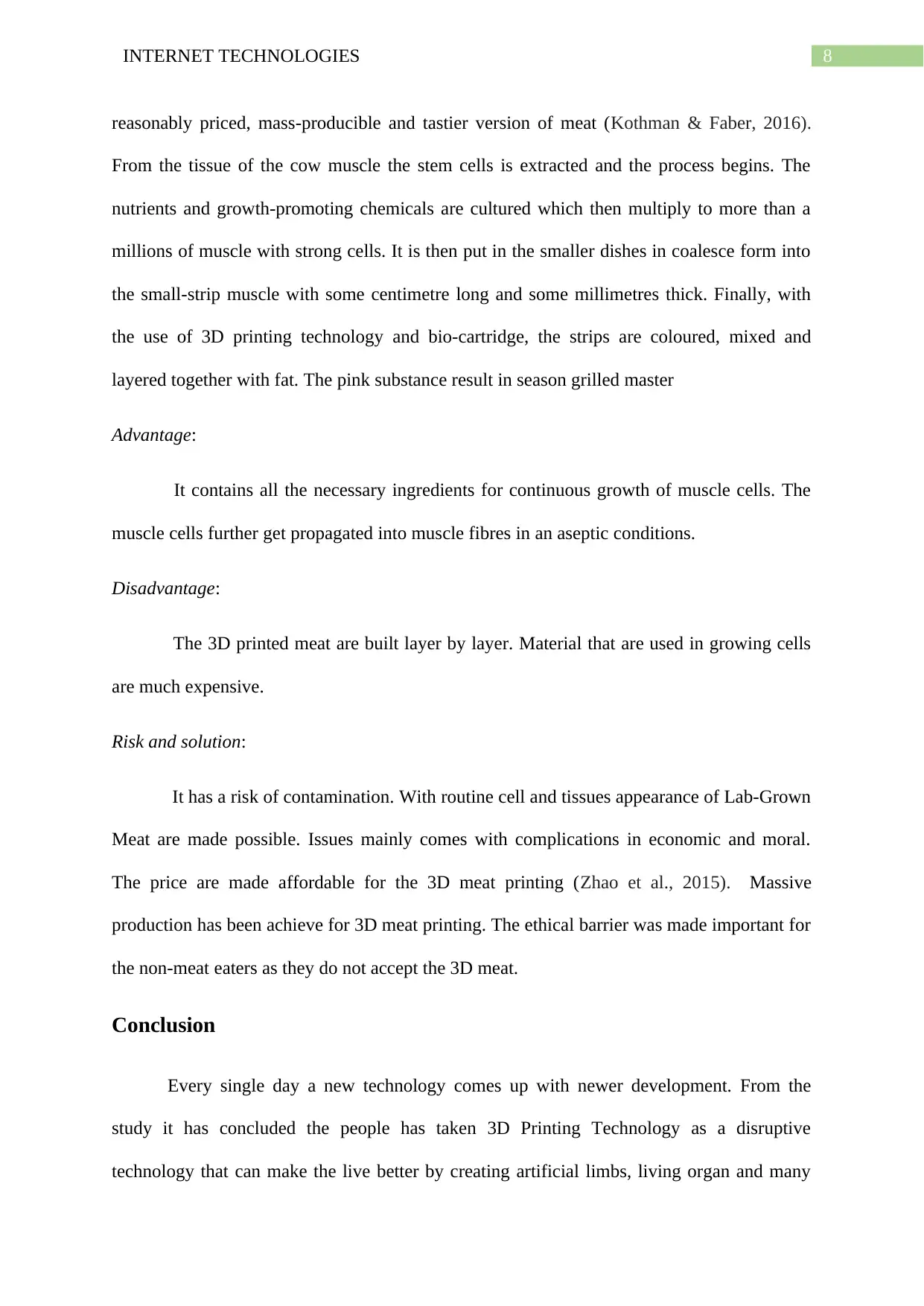
8INTERNET TECHNOLOGIES
reasonably priced, mass-producible and tastier version of meat (Kothman & Faber, 2016).
From the tissue of the cow muscle the stem cells is extracted and the process begins. The
nutrients and growth-promoting chemicals are cultured which then multiply to more than a
millions of muscle with strong cells. It is then put in the smaller dishes in coalesce form into
the small-strip muscle with some centimetre long and some millimetres thick. Finally, with
the use of 3D printing technology and bio-cartridge, the strips are coloured, mixed and
layered together with fat. The pink substance result in season grilled master
Advantage:
It contains all the necessary ingredients for continuous growth of muscle cells. The
muscle cells further get propagated into muscle fibres in an aseptic conditions.
Disadvantage:
The 3D printed meat are built layer by layer. Material that are used in growing cells
are much expensive.
Risk and solution:
It has a risk of contamination. With routine cell and tissues appearance of Lab-Grown
Meat are made possible. Issues mainly comes with complications in economic and moral.
The price are made affordable for the 3D meat printing (Zhao et al., 2015). Massive
production has been achieve for 3D meat printing. The ethical barrier was made important for
the non-meat eaters as they do not accept the 3D meat.
Conclusion
Every single day a new technology comes up with newer development. From the
study it has concluded the people has taken 3D Printing Technology as a disruptive
technology that can make the live better by creating artificial limbs, living organ and many
reasonably priced, mass-producible and tastier version of meat (Kothman & Faber, 2016).
From the tissue of the cow muscle the stem cells is extracted and the process begins. The
nutrients and growth-promoting chemicals are cultured which then multiply to more than a
millions of muscle with strong cells. It is then put in the smaller dishes in coalesce form into
the small-strip muscle with some centimetre long and some millimetres thick. Finally, with
the use of 3D printing technology and bio-cartridge, the strips are coloured, mixed and
layered together with fat. The pink substance result in season grilled master
Advantage:
It contains all the necessary ingredients for continuous growth of muscle cells. The
muscle cells further get propagated into muscle fibres in an aseptic conditions.
Disadvantage:
The 3D printed meat are built layer by layer. Material that are used in growing cells
are much expensive.
Risk and solution:
It has a risk of contamination. With routine cell and tissues appearance of Lab-Grown
Meat are made possible. Issues mainly comes with complications in economic and moral.
The price are made affordable for the 3D meat printing (Zhao et al., 2015). Massive
production has been achieve for 3D meat printing. The ethical barrier was made important for
the non-meat eaters as they do not accept the 3D meat.
Conclusion
Every single day a new technology comes up with newer development. From the
study it has concluded the people has taken 3D Printing Technology as a disruptive
technology that can make the live better by creating artificial limbs, living organ and many
⊘ This is a preview!⊘
Do you want full access?
Subscribe today to unlock all pages.

Trusted by 1+ million students worldwide
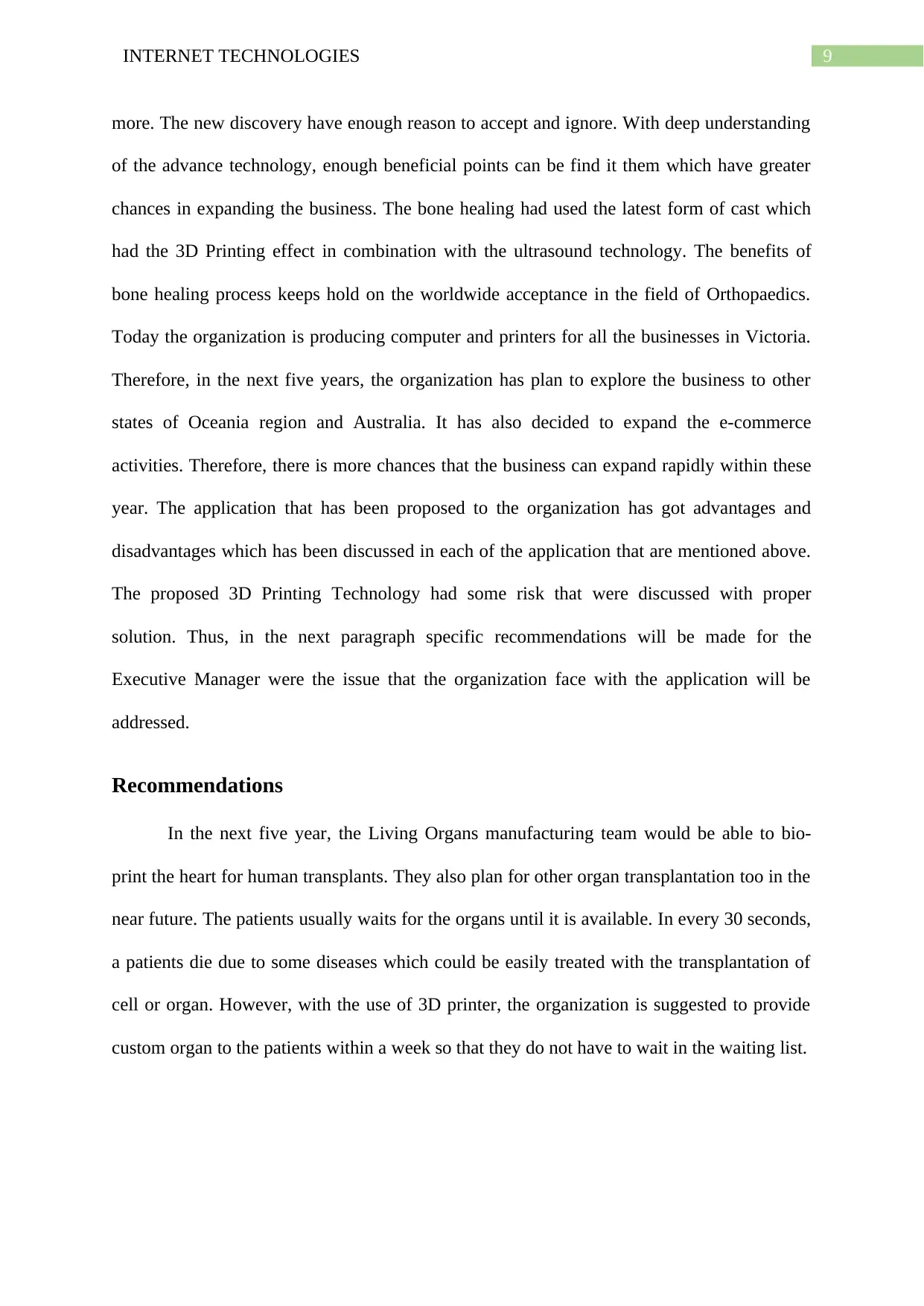
9INTERNET TECHNOLOGIES
more. The new discovery have enough reason to accept and ignore. With deep understanding
of the advance technology, enough beneficial points can be find it them which have greater
chances in expanding the business. The bone healing had used the latest form of cast which
had the 3D Printing effect in combination with the ultrasound technology. The benefits of
bone healing process keeps hold on the worldwide acceptance in the field of Orthopaedics.
Today the organization is producing computer and printers for all the businesses in Victoria.
Therefore, in the next five years, the organization has plan to explore the business to other
states of Oceania region and Australia. It has also decided to expand the e-commerce
activities. Therefore, there is more chances that the business can expand rapidly within these
year. The application that has been proposed to the organization has got advantages and
disadvantages which has been discussed in each of the application that are mentioned above.
The proposed 3D Printing Technology had some risk that were discussed with proper
solution. Thus, in the next paragraph specific recommendations will be made for the
Executive Manager were the issue that the organization face with the application will be
addressed.
Recommendations
In the next five year, the Living Organs manufacturing team would be able to bio-
print the heart for human transplants. They also plan for other organ transplantation too in the
near future. The patients usually waits for the organs until it is available. In every 30 seconds,
a patients die due to some diseases which could be easily treated with the transplantation of
cell or organ. However, with the use of 3D printer, the organization is suggested to provide
custom organ to the patients within a week so that they do not have to wait in the waiting list.
more. The new discovery have enough reason to accept and ignore. With deep understanding
of the advance technology, enough beneficial points can be find it them which have greater
chances in expanding the business. The bone healing had used the latest form of cast which
had the 3D Printing effect in combination with the ultrasound technology. The benefits of
bone healing process keeps hold on the worldwide acceptance in the field of Orthopaedics.
Today the organization is producing computer and printers for all the businesses in Victoria.
Therefore, in the next five years, the organization has plan to explore the business to other
states of Oceania region and Australia. It has also decided to expand the e-commerce
activities. Therefore, there is more chances that the business can expand rapidly within these
year. The application that has been proposed to the organization has got advantages and
disadvantages which has been discussed in each of the application that are mentioned above.
The proposed 3D Printing Technology had some risk that were discussed with proper
solution. Thus, in the next paragraph specific recommendations will be made for the
Executive Manager were the issue that the organization face with the application will be
addressed.
Recommendations
In the next five year, the Living Organs manufacturing team would be able to bio-
print the heart for human transplants. They also plan for other organ transplantation too in the
near future. The patients usually waits for the organs until it is available. In every 30 seconds,
a patients die due to some diseases which could be easily treated with the transplantation of
cell or organ. However, with the use of 3D printer, the organization is suggested to provide
custom organ to the patients within a week so that they do not have to wait in the waiting list.
Paraphrase This Document
Need a fresh take? Get an instant paraphrase of this document with our AI Paraphraser
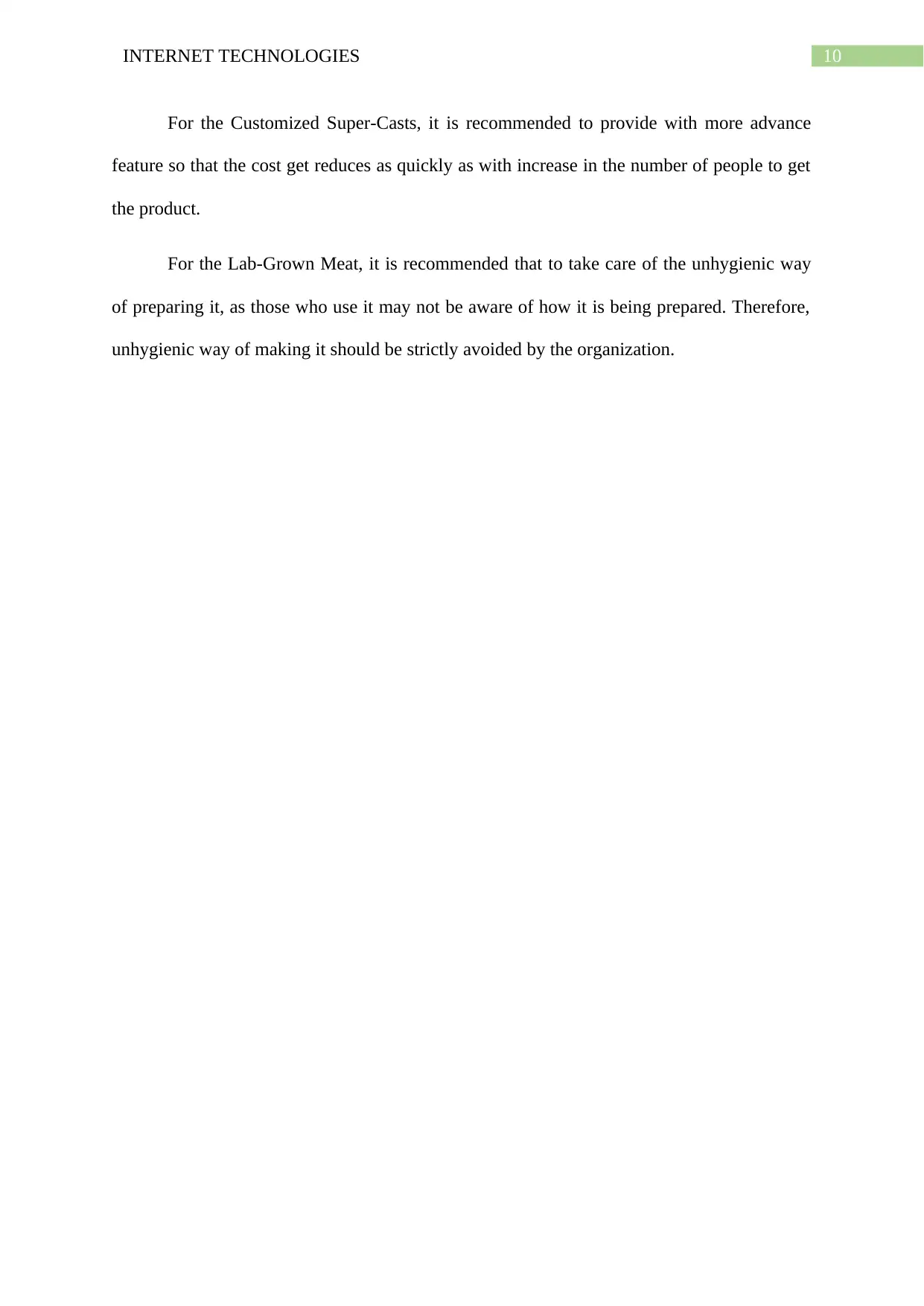
10INTERNET TECHNOLOGIES
For the Customized Super-Casts, it is recommended to provide with more advance
feature so that the cost get reduces as quickly as with increase in the number of people to get
the product.
For the Lab-Grown Meat, it is recommended that to take care of the unhygienic way
of preparing it, as those who use it may not be aware of how it is being prepared. Therefore,
unhygienic way of making it should be strictly avoided by the organization.
For the Customized Super-Casts, it is recommended to provide with more advance
feature so that the cost get reduces as quickly as with increase in the number of people to get
the product.
For the Lab-Grown Meat, it is recommended that to take care of the unhygienic way
of preparing it, as those who use it may not be aware of how it is being prepared. Therefore,
unhygienic way of making it should be strictly avoided by the organization.
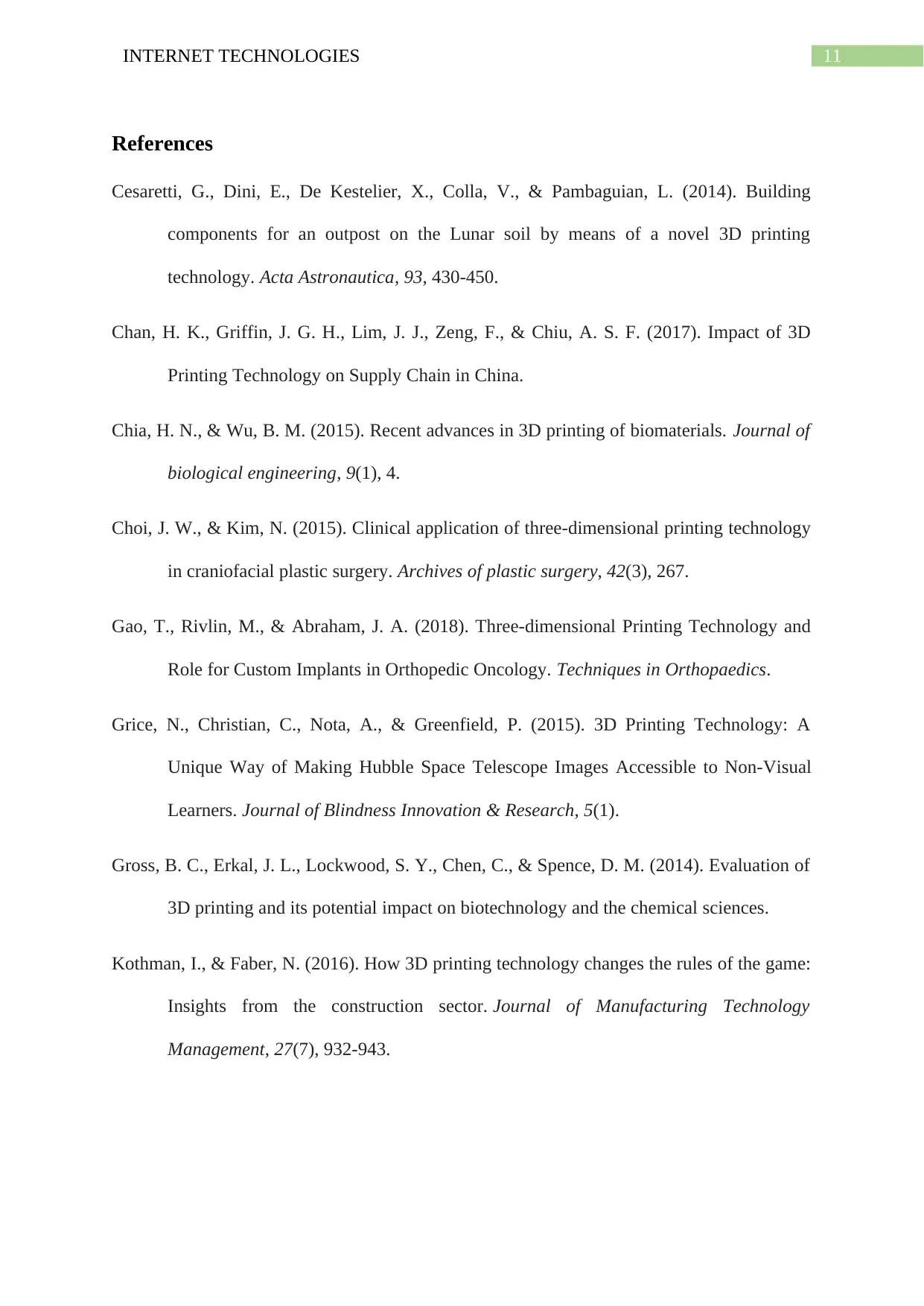
11INTERNET TECHNOLOGIES
References
Cesaretti, G., Dini, E., De Kestelier, X., Colla, V., & Pambaguian, L. (2014). Building
components for an outpost on the Lunar soil by means of a novel 3D printing
technology. Acta Astronautica, 93, 430-450.
Chan, H. K., Griffin, J. G. H., Lim, J. J., Zeng, F., & Chiu, A. S. F. (2017). Impact of 3D
Printing Technology on Supply Chain in China.
Chia, H. N., & Wu, B. M. (2015). Recent advances in 3D printing of biomaterials. Journal of
biological engineering, 9(1), 4.
Choi, J. W., & Kim, N. (2015). Clinical application of three-dimensional printing technology
in craniofacial plastic surgery. Archives of plastic surgery, 42(3), 267.
Gao, T., Rivlin, M., & Abraham, J. A. (2018). Three-dimensional Printing Technology and
Role for Custom Implants in Orthopedic Oncology. Techniques in Orthopaedics.
Grice, N., Christian, C., Nota, A., & Greenfield, P. (2015). 3D Printing Technology: A
Unique Way of Making Hubble Space Telescope Images Accessible to Non-Visual
Learners. Journal of Blindness Innovation & Research, 5(1).
Gross, B. C., Erkal, J. L., Lockwood, S. Y., Chen, C., & Spence, D. M. (2014). Evaluation of
3D printing and its potential impact on biotechnology and the chemical sciences.
Kothman, I., & Faber, N. (2016). How 3D printing technology changes the rules of the game:
Insights from the construction sector. Journal of Manufacturing Technology
Management, 27(7), 932-943.
References
Cesaretti, G., Dini, E., De Kestelier, X., Colla, V., & Pambaguian, L. (2014). Building
components for an outpost on the Lunar soil by means of a novel 3D printing
technology. Acta Astronautica, 93, 430-450.
Chan, H. K., Griffin, J. G. H., Lim, J. J., Zeng, F., & Chiu, A. S. F. (2017). Impact of 3D
Printing Technology on Supply Chain in China.
Chia, H. N., & Wu, B. M. (2015). Recent advances in 3D printing of biomaterials. Journal of
biological engineering, 9(1), 4.
Choi, J. W., & Kim, N. (2015). Clinical application of three-dimensional printing technology
in craniofacial plastic surgery. Archives of plastic surgery, 42(3), 267.
Gao, T., Rivlin, M., & Abraham, J. A. (2018). Three-dimensional Printing Technology and
Role for Custom Implants in Orthopedic Oncology. Techniques in Orthopaedics.
Grice, N., Christian, C., Nota, A., & Greenfield, P. (2015). 3D Printing Technology: A
Unique Way of Making Hubble Space Telescope Images Accessible to Non-Visual
Learners. Journal of Blindness Innovation & Research, 5(1).
Gross, B. C., Erkal, J. L., Lockwood, S. Y., Chen, C., & Spence, D. M. (2014). Evaluation of
3D printing and its potential impact on biotechnology and the chemical sciences.
Kothman, I., & Faber, N. (2016). How 3D printing technology changes the rules of the game:
Insights from the construction sector. Journal of Manufacturing Technology
Management, 27(7), 932-943.
⊘ This is a preview!⊘
Do you want full access?
Subscribe today to unlock all pages.

Trusted by 1+ million students worldwide
1 out of 14
Related Documents
Your All-in-One AI-Powered Toolkit for Academic Success.
+13062052269
info@desklib.com
Available 24*7 on WhatsApp / Email
![[object Object]](/_next/static/media/star-bottom.7253800d.svg)
Unlock your academic potential
Copyright © 2020–2025 A2Z Services. All Rights Reserved. Developed and managed by ZUCOL.





